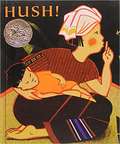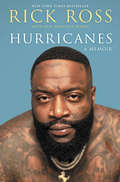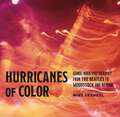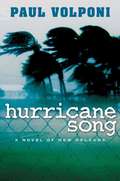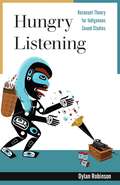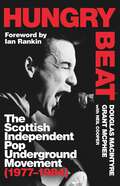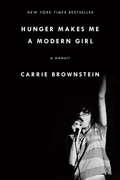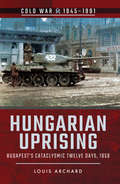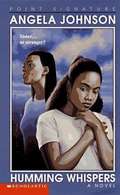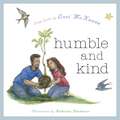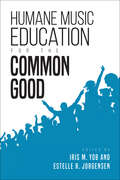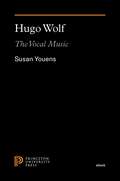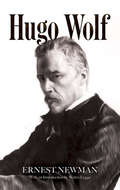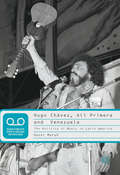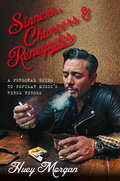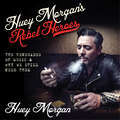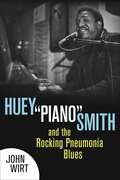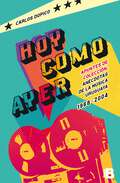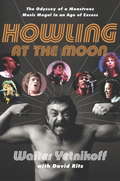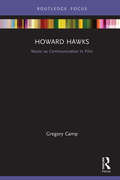- Table View
- List View
Hush: A Thai Lullaby
by Minfong HoIn an endearing lullaby, a mother asks a lizard, a monkey, and a water buffalo to be quiet and not disturb her sleeping baby.
Hush, Little Alien
by Daniel KirkA goodnight book, to the tune of "Hush Little Baby, Don't Say a Word, Papa's Gonna Buy You a Mockingbird"
Hush Little Baby
by Marla FrazeeIn an old lullaby, a baby is promised an assortment of presents from its adoring parent
Hurricanes: A Memoir
by Neil Martinez-Belkin Rick RossThe highly anticipated memoir from hip-hop icon Rick Ross chronicles his coming of age amid Miami’s crack epidemic, his star-studded controversies and his unstoppable rise to fame. <P><P>Rick Ross is an indomitable presence in the music industry, but few people know his full story. Now, for the first time, Ross offers a vivid, dramatic and unexpectedly candid account of his early childhood, his tumultuous adolescence and his dramatic ascendancy in the world of hip-hop. <P><P>Born William Leonard Roberts II, Ross grew up “across the bridge,” in a Miami at odds with the glitzy beaches, nightclubs and yachts of South Beach. In the aftermath of the 1980 race riots and the Mariel boatlift, Ross came of age at the height of the city’s crack epidemic, when home invasions and execution-style killings were commonplace. <P><P>Still, in the midst of the chaos and danger that surrounded him, Ross flourished, first as a standout high school football player and then as a dope boy in Carol City’s notorious Matchbox housing projects. All the while he honed his musical talent, overcoming setback after setback until a song called “Hustlin’” changed his life forever. <P><P>From the making of “Hustlin’” to his first major label deal with Def Jam, to the controversy surrounding his past as a correctional officer and the numerous health scares, arrests and feuds he had to transcend along the way, Hurricanes is a revealing portrait of one of the biggest stars in the rap game, and an intimate look at the birth of an artist. <P><P><b> A New York Times Bestseller </b>
Hurricanes of Color: Iconic Rock Photography from the Beatles to Woodstock and Beyond (American Music History)
by Mike FrankelIn 1964, fifteen-year-old Mike Frankel found himself among professional photojournalists covering a Beatles concert during the band’s first tour in the United States. A few years later, he was a regular photographer at the Fillmore East, a storied venue in classic rock. And in 1969, he was onstage at Woodstock, documenting one of the most important events in American music history.Featuring Frankel’s stunning photographs of nearly every major rock figure from the 1960s and ’70s—including Led Zeppelin, Pink Floyd, the Rolling Stones, Janis Joplin, and the Grateful Dead—as well as many unpublished images of the Beatles, Hurricanes of Color chronicles an extraordinary moment. Frankel, who was for a time a personal photographer for Jefferson Airplane and Hot Tuna, developed an innovative style—one that layered images with multiple exposures to capture the spirit of the music of the era and the experience of listening to the bands live.A must-have for fans of classic rock, this is a spectacular and profound collection of photography that complements the music of the world’s biggest performers.
Hurricane Song (A Novel Of New Orleans)
by Paul VolponiAn author known for books that capture the pulse of urban life in New York City creates a gripping hour-by-hour portrayal of what life was like for those left behind in New Orleans as Hurricane Katrina raged, told from the point of view of a young man inside the Superdome.
Hungry Listening: Resonant Theory for Indigenous Sound Studies (Indigenous Americas)
by Dylan RobinsonWInner of the Best First Book from the Native American and Indigenous Studies Association Winner of the Labriola Center American Indian National Book Award Winner of the Ann Saddlemyer Award from the Canadian Association for Theatre ResearchReimagining how we understand and write about the Indigenous listening experienceHungry Listening is the first book to consider listening from both Indigenous and settler colonial perspectives. A critical response to what has been called the &“whiteness of sound studies,&” Dylan Robinson evaluates how decolonial practices of listening emerge from increasing awareness of our listening positionality. This, he argues, involves identifying habits of settler colonial perception and contending with settler colonialism&’s &“tin ear&” that renders silent the epistemic foundations of Indigenous song as history, law, and medicine. With case studies on Indigenous participation in classical music, musicals, and popular music, Hungry Listening examines structures of inclusion that reinforce Western musical values. Alongside this inquiry on the unmarked terms of inclusion in performing arts organizations and compositional practice, Hungry Listening offers examples of &“doing sovereignty&” in Indigenous performance art, museum exhibition, and gatherings that support an Indigenous listening resurgence.Throughout the book, Robinson shows how decolonial and resurgent forms of listening might be affirmed by writing otherwise about musical experience. Through event scores, dialogic improvisation, and forms of poetic response and refusal, he demands a reorientation toward the act of reading as a way of listening. Indigenous relationships to the life of song are here sustained in writing that finds resonance in the intersubjective experience between listener, sound, and space.
Hungry Beat: The Scottish Independent Pop Underground Movement (1977-1984)
by Douglas MacIntyre Grant McPhee'Hungry Beat is the story of an all-too-brief era where the short-circuiting of that industry seemed viable. But hell, the times were luminous as was the music these artists made. The songs and many of the players remain, and here they tell their story and lick their wounds' Ian RankinThe immense cultural contribution made by two maverick Scottish independent music labels, Fast Product and Postcard, cannot be underestimated. Bob Last and Hilary Morrison in Edinburgh, followed by Alan Horne and Edwyn Collins in Glasgow helped to create a confidence in being Scottish that hitherto had not existed in pop music (or the arts in general in Scotland). Their fierce independent spirit stamped a mark of quality and intelligence on everything they achieved, as did their role in the emergence of regional independent labels and cultural agitators, such as Rough Trade, Factory and Zoo.Hungry Beat is a definitive oral history of these labels and the Scottish post-punk period. Covering the period 1977-1984, the book begins with the Subway Sect and the Slits performance on the White Riot tour in Edinburgh and takes us through to Bob Last shepherding the Human League from experimental electronic artists on Fast Product to their triumphant number one single in the UK and USA, Don't You Want Me. Largely built on interviews for Grant McPhee's Big Gold Dream film with Last, Hilary Morrison, Paul Morley and members of The Human League, Scars, The Mekons, Fire Engines, Josef K, Aztec Camera, The Go-Betweens and The Bluebells, Hungry Beat offers a comprehensive overview of one of the most important periods of Scottish cultural output and the two labels that changed the landscape of British music.
Hungry Beat: The Scottish Independent Pop Underground Movement (1977-1984)
by Douglas MacIntyre Grant McPhee'Hungry Beat is the story of an all-too-brief era where the short-circuiting of that industry seemed viable. But hell, the times were luminous as was the music these artists made. The songs and many of the players remain, and here they tell their story and lick their wounds' Ian RankinThe immense cultural contribution made by two maverick Scottish independent music labels, Fast Product and Postcard, cannot be underestimated. Bob Last and Hilary Morrison in Edinburgh, followed by Alan Horne and Edwyn Collins in Glasgow helped to create a confidence in being Scottish that hitherto had not existed in pop music (or the arts in general in Scotland). Their fierce independent spirit stamped a mark of quality and intelligence on everything they achieved, as did their role in the emergence of regional independent labels and cultural agitators, such as Rough Trade, Factory and Zoo.Hungry Beat is a definitive oral history of these labels and the Scottish post-punk period. Covering the period 1977-1984, the book begins with the Subway Sect and the Slits performance on the White Riot tour in Edinburgh and takes us through to Bob Last shepherding the Human League from experimental electronic artists on Fast Product to their triumphant number one single in the UK and USA, Don't You Want Me. Largely built on interviews for Grant McPhee's Big Gold Dream film with Last, Hilary Morrison, Paul Morley and members of The Human League, Scars, The Mekons, Fire Engines, Josef K, Aztec Camera, The Go-Betweens and The Bluebells, Hungry Beat offers a comprehensive overview of one of the most important periods of Scottish cultural output and the two labels that changed the landscape of British music.
Hunger Makes Me a Modern Girl: A Memoir
by Carrie Brownstein<P>From the guitarist of the pioneering band Sleater-Kinney, the book Kim Gordon says "everyone has been waiting for" -- a candid, funny, and deeply personal look at making a life--and finding yourself--in music. <P>Before Carrie Brownstein became a music icon, she was a young girl growing up in the Pacific Northwest just as it was becoming the setting for one the most important movements in rock history. <P> Seeking a sense of home and identity, she would discover both while moving from spectator to creator in experiencing the power and mystery of a live performance. <P>With Sleater-Kinney, Brownstein and her bandmates rose to prominence in the burgeoning underground feminist punk-rock movement that would define music and pop culture in the 1990s. <P>They would be cited as "America's best rock band" by legendary music critic Greil Marcus for their defiant, exuberant brand of punk that resisted labels and limitations, and redefined notions of gender in rock. <P>HUNGER MAKES ME A MODERN GIRL is an intimate and revealing narrative of her escape from a turbulent family life into a world where music was the means toward self-invention, community, and rescue. <P>Along the way, Brownstein chronicles the excitement and contradictions within the era's flourishing and fiercely independent music subculture, including experiences that sowed the seeds for the observational satire of the popular television series Portlandia years later. <P>With deft, lucid prose Brownstein proves herself as formidable on the page as on the stage. <P>Accessibly raw, honest and heartfelt, this book captures the experience of being a young woman, a born performer and an outsider, and ultimately finding one's true calling through hard work, courage and the intoxicating power of rock and roll.
Hungarian Uprising: Budapest's Cataclysmic Twelve Days, 1956 (Cold War, 1945–1991)
by Louis ArchardWhen the world held its breath It is more than 25 years since the end of the Cold War. It began over 75 years ago, in 1944 long before the last shots of the Second World War had echoed across the wastelands of Eastern Europe with the brutal Greek Civil War. The battle lines are no longer drawn, but they linger on, unwittingly or not, in conflict zones such as Syria, Somalia and Ukraine. In an era of mass-produced AK-47s and ICBMs, one such flashpoint was Hungary Soviet troops had occupied Hungary in 1945 as they pushed towards Germany and by 1949 the country was ruled by a communist government that towed the Soviet line. Resentment at the system eventually boiled over at the end of October 1956. Protests erupted on the streets of Budapest and, as the violence spread, the government fell and was replaced by a new, more moderate regime. However, the intention of the new government to withdraw from the Warsaw Pact and declare neutrality in the Cold War proved just too much for Soviet leader Nikita Khrushchev.Soviet forces had intervened at the beginning of events to help the former regime keep order but were withdrawn at the end of October, only to return in November and quell the uprising with blunt force. Thousands were arrested, many of whom were imprisoned and more than 300 executed. An estimated 200,000 fled Hungary as refugees. Despite advocating a policy of rolling back Soviet influence, the US and other western powers were helpless to stop the suppression of the uprising, which marked a realization that the Cold War in Europe had reached a stalemate.
Humming Whispers
by Angela JohnsonNicole was only fourteen when she first started to hear the voices. Voices that only she can hear. Voices that will never, ever go away. Now Sophy is fourteen. And she's afraid she'll end up like her older sister. That the whispers will start to call to her. That they'll make her do crazy things. That people will treat her the way they do Nicole. But the old saying about blood being thicker than water is very true. And no matter how hard she tries to look the other way, Sophy knows her sister will always be a very important part of her life. No matter what ...
Humble and Kind: A Children's Picture Book (LyricPop)
by Lori McKennaAward-winning songwriter Lori McKenna’s iconic song—as popularized by Tim McGraw—is the perfect basis for a picture book that celebrates family and togetherness. One of Kirkus Reviews' 50 Most Anticipated Books of 2021 “Children will feel reassured by the sentiments within this expressive extension of the music, and a sweet daydream of a picture book. ” —School Library Journal "Hold the door, say please, say thank you Don’t steal, don’t cheat, and don’t lie I know you got mountains to climb but Always stay humble and kind . . ." Humble and Kind is a picture book based on Lori McKenna’s song, popularized by Tim McGraw. McKenna later recorded the song on her ninth studio album, The Bird and the Rifle. Lovingly illustrated by Katherine Blackmore, this gentle picture book tells the story of a family who is striving to remain humble and kind. We follow the family through their daily lives as they find different ways to lend a hand to each other and to their broader community. Full of touching scenes of familial relationships, Humble and Kind will teach adults and children alike the power of family while introducing them to this beautiful song.
Humble and Kind: A Children's Picture Book (LyricPop #0)
by Lori McKennaAward-winning songwriter Lori McKenna's iconic song--as popularized by Tim McGraw--is the perfect basis for a picture book that celebrates family and togetherness. Hold the door, say please, say thank you Don't steal, don't cheat, and do
Humane Music Education for the Common Good (Counterpoints: Music and Education)
by Iris M. Yob and Estelle R. JorgensenWhy teach music? Who deserves a music education? Can making and learning about music serve the common good? A collection of essays considers the answers.In Humane Music Education for the Common Good, scholars and educators from around the world offer unique responses to the recent UNESCO report titled Rethinking Education: Toward the Common Good. This report suggests how, through purpose, policy, and pedagogy, education can and must respond to the challenges of our day in ways that respect and nurture all members of the human family.The contributors use this report as a framework to explore the implications and complexities that it raises. The book begins with analytical reflections on the report and then explores pedagogical case studies and practical models of music education that address social justice, inclusion, individual nurturance, and active involvement in the greater public welfare. The collection concludes by looking to the future, asking what more should be considered, and exploring how these ideals can be even more fully realized. This volume boldly expands the boundaries of the UNESCO report to reveal new ways to think about, be invested in, and use music education as a center for social change both today and going forward.
Hugo Wolf: The Vocal Music
by Susan YouensA groundbreaking look at one of the great song composers of the late Romantic periodIn the virtual cottage industry of works on fin de siècle Vienna, Hugo Wolf (1860–1903) has been somewhat neglected, perhaps because he was the master of a small genre—the late Romantic lied—and never truly made his mark in the larger forms that command greater public attention. But in the realm of song, he is among the greatest inheritors of Schubert and Schumann, one who was both a traditionalist and a modernist. When the Viennese critic Eduard Hanslick disapprovingly dubbed Wolf &“the Richard Wagner of the lied,&” he was paying oblique homage to Wolf&’s genius as a song composer in the most modern manner.In this book, Susan Youens examines five aspects of Wolf&’s compositional art, each exemplifying a different synthesis of traditionalism and modernity and spanning his entire, tragically brief creative life, from his first efforts to his lapse into insanity in 1897. She discusses Wolf&’s youthful imitations of Schumann, his genius for comic songs of a kind unlike any of his predecessors, his part in the ballad revival of the late nineteenth century, Wolf in relation to his contemporaries, and his pursuit of operatic fame. Youens looks as closely at the poetic texts as she does the music and includes numerous previously unpublished sketches and fragments, examples from songs now long out of print and difficult to obtain, and citations from Wolf&’s vivid letters and other sources of the period.
Hugo Wolf (Dover Books On Music: Composers)
by Ernest Newman Walter Legge Prof. Roelof OostwoudHailed as "very interesting and very stimulating" by The New York Times, this critical biography explores the life and music ofa supreme master of German song. Austrian composer Hugo Wolf (1860-1903) wrote hundreds of lieder despite the often-overwhelming effects of depression. This two-part volume contains both a biographical narrative and a sensitive survey of the composer's unique contributions to songwriting.Beginning with Wolf's early struggles with academic failures and poverty, the book traces his brief and controversial career as a Viennese music critic, outlining the alternate periods of productivity and paralysis that led to his final mental collapse and untimely death. Author Ernest Newman writes with exuberance and keen perception of Wolf's flowering as a composer and the birth of his song cycles -- the Keller songs, the Spanish, Mörike, Goethe, and Eichendorff volumes -- in addition to critiquing a variety of other choral and instrumental works. Music lovers of all ages will appreciate this guide to an extraordinary composer's life and works.
Hugo Chávez, Alí Primera and Venezuela
by Hazel MarshUnlike much of the literature on Venezuela in the Ch#65533;vez period, this book shifts focus away from 'top down' perspectives to examine how Venezuelan folksinger Al#65533; Primera (1942-1985) became intertwined with Venezuelan politics, both during his lifetime and posthumously. Al#65533;'s 'Necessary Songs' offered cultural resources that enabled Ch#65533;vez to connect with pre-existing patterns of grassroots activism in ways that resonated deeply with the poor and marginalised masses. Official support for Al#65533;'s legacy led the songs to be used in new ways in the Ch#65533;vez period, as Venezuelans actively engaged with them to redefine themselves in relation to the state and to reach new understandings of their place within a changed society. This book is essential reading not only for those interested in popular music and politics, but for all those seeking to better understand how Ch#65533;vez was able to successfully identify himself so profoundly with the Venezuelan masses, and they with him.
Huey Morgans Rebel Heroes: The Renegades Of Music And Why We Still Need Them
by Huey MorganThe defining sounds of popular music - blues, rock 'n' roll, punk, hip-hop - were shaped and driven by rebel voices: whether that was Robert Johnson and Billie Holiday in the 1920s and 30s, or the likes of Hendrix, Janis Joplin and Joe Strummer in the 1960s and 70s. In more recent years those truly ground- and rule-breaking voices have been harder to hear, and in Sinners, Chancers & Renegades, Huey Morgan shines a spotlight on the rebel spirits of music in the last century and looks at why there are so few around today. The book includes personal anecdotes from Huey of his experiences listening to these artists as a child, and of meeting - and in some cases playing with - some of them as a musician himself in later years.
Huey Morgan's Rebel Heroes: The Renegades of Music & Why We Still Need Them
by Huey MorganThe defining sounds of popular music - blues, rock 'n' roll, punk, hip-hop - were shaped and driven by rebel voices: whether that was Robert Johnson and Billie Holiday in the 1920-40s, or the likes of Jimi Hendrix, Janis Joplin and Joe Strummer in the 1960s and 70s. Truly ground- and rule-breaking voices have been drowned out by pop-by-numbers acts in more recent years, and in Rebel Heroes, Huey Morgan investigates where music started to lose its soul, and why the lessons of those renegade spirits of yesteryear are still so vital. The book is steeped in Huey's love for, and knowledge of, music and is full of personal anecdotes and stories of some of the greatest musicians to have graced us with their talent.
Huey Morgan's Rebel Heroes: The Renegades of Music & Why We Still Need Them
by Huey MorganThe defining sounds of popular music - blues, rock 'n' roll, punk, hip-hop - were shaped and driven by rebel voices: whether that was Robert Johnson and Billie Holiday in the 1920-40s, or the likes of Jimi Hendrix, Janis Joplin and Joe Strummer in the 1960s and 70s. Truly ground- and rule-breaking voices have been drowned out by pop-by-numbers acts in more recent years, and in Rebel Heroes, Huey Morgan investigates where music started to lose its soul, and why the lessons of those renegade spirits of yesteryear are still so vital. The book is steeped in Huey's love for, and knowledge of, music and is full of personal anecdotes and stories of some of the greatest musicians to have graced us with their talent.(p) 2015 Octopus Publishing Group
Huey "Piano" Smith and the Rocking Pneumonia Blues: A Novel
by John WirtHuey "Piano" Smith's musical legacy stands alongside that of fellow New Orleans legends Dr. John, Fats Domino, Ernie K-Doe, and Allen Toussaint. His 1957 classic, "Rocking Pneumonia and the Boogie Woogie Flu," made Billboard's top R&B singles chart, and hundreds of artists including Aerosmith, the Grateful Dead, the Beach Boys, Johnny Rivers, and Chubby Checker have recorded his songs. The first biography of the artist responsible for hits "Don't You Just Know It," "High Blood Pressure," and "Sea Cruise," Huey "Piano" Smith and the Rocking Pneumonia Blues follows the musician's extraordinary life from his Depression-era childhood to his teen years as a pianist for blues star Guitar Slim to his mainstream success in the 1950s and '60s. Drawing from extensive interviews and court records, author and journalist John Wirt also provides new insights on Smith's professional disappointments and financial struggles in the 1980s and '90s as he battled over royalties from his most successful and profitable work. An enigmatic and guarded personality in a profession of extroverted performers, Smith made farreaching contributions to the New Orleans music scene as a songwriter, pianist, and producer. Wirt reveals that Smith's numerous collaborations with other artists -- including the Clowns, the Pitter Pats, the Hueys, and Shindig Smith and the Soul Shakers -- served as vehicles for his creative vision rather than simply as an anonymous backup for a leading front man.Throughout this intimate account, Wirt details Smith's significant impact on rock and roll history and underscores both the longevity of his music -- which has entertained and inspired for over five decades -- and the musician's personal endurance in the face of hardship and opposition.
Hoy como ayer: Apuntes de colección. Anécdotas de la música uruguaya 1968-2004
by Carlos DopicoCarlos Dopico nos propone un viaje emotivo por las canciones y los artistas que son parte de la historia de los uruguayos. Un regreso a la banda sonora de nuestras vidas. La música uruguaya es reconocida por su calidad en todo el mundo. Artistas originales, discos emblemáticos, canciones que se han convertido en himnos, forman parte de un valioso acervo cultural que ha aportado a la construcción de nuestra identidad. Durante muchos años, Carlos Dopico fue un activo partícipe y testigo de la movida musical del Uruguay, dejando testimonio de las luces y sombras de un medio artístico repleto de talento y creatividad, pero sometido a los rigores de un mercado pequeño y con pocos recursos. En este libro se dan cita relatos, anécdotas, testimonios y reflexiones en primera persona que pintan una época. Es un viaje a través de los secretos de las canciones que nos marcaron. Rock, punk, reggae, pop, hip-hop, blues, canción urbana, y otros géneros desfilan por estas páginas, haciéndonos revivir la emoción de la música. Hoy como ayer, la nostalgia y la emoción se traslucen en la escritura certera y reflexiva de Dopico, y en la palabra de los autores de la banda sonora de nuestras vidas.
Howling at the Moon: The Odyssey of a Monstrous Music Mogul in an Age of Excess
by Walter Yetnikoff David RitzShow biz memoir at its name-dropping, bridge-burning, profane best: the music industry&’s most outspoken, outrageous, and phenomenally successful executive delivers a rollicking memoir of pop music&’s heyday.During the 1970s and '80s the music business was dominated by a few major labels and artists such as Michael Jackson, Bruce Springsteen, the Rolling Stones, Bob Dylan, Billy Joel, Paul Simon, Barbra Streisand and James Taylor. They were all under contract to CBS Records, making it the most successful label of the era. And, as the company&’s president, Walter Yetnikoff was the ruling monarch. He was also the most flamboyant, volatile and controversial personality to emerge from an industry and era defined by sex, drugs and debauchery. Having risen from working-class Brooklyn and the legal department of CBS, Yetnikoff, who freely admitted to being tone deaf, was an unlikely label head. But he had an uncanny knack for fostering talent and intimidating rivals with his appalling behavior—usually fueled by an explosive combination of cocaine and alcohol. His tantrums, appetite for mind-altering substances and sexual exploits were legendary. In Japan to meet the Sony executives who acquired CBS during his tenure, Walter was assigned a minder who confined him to a hotel room. True to form, Walter raided the minibar, got blasted and, seeing no other means of escape, opened a hotel window and vented his rage by literally howling at the moon. In Howling at the Moon, Yetnikoff traces his journey as he climbed the corporate mountain, danced on its summit and crashed and burned. We see how Walter became the father-confessor to Michael Jackson as the King of Pop reconstructed his face and agonized over his image while constructing Thriller (and how, after it won seven Grammies, Jackson made the preposterous demand that Walter take producer Quincy Jones&’s name off the album); we see Walter, in maniacal pursuit of a contract, chase the Rolling Stones around the world and nearly come to blows with Mick Jagger in the process; we get the tale of how Walter and Marvin Gaye—fresh from the success of &“Sexual Healing&”—share the same woman, and of how Walter bonds with Bob Dylan because of their mutual Jewishness. At the same time we witness Yetnikoff&’s clashes with Barry Diller, David Geffen, Tommy Mottola, Allen Grubman and a host of others. Seemingly, the more Yetnikoff feeds his cravings for power, sex, liquor and cocaine, the more profitable CBS becomes—from $485 million to well over $2 billion—until he finally succumbs, ironically, not to substances, but to a corporate coup. Reflecting on the sinister cycle that left his career in tatters and CBS flush with cash, Yetnikoff emerges with a hunger for redemption and a new reverence for his working-class Brooklyn roots.Ruthlessly candid, uproariously hilarious and compulsively readable, Howling at the Moon is a blistering You&’ll Never Eat Lunch in this Town Again of the music industry.
Howard Hawks: Music as Communication in Film (Filmmakers and Their Soundtracks)
by Gregory CampKnown for creating classic films including His Girl Friday, The Big Sleep, Bringing Up Baby, and Gentlemen Prefer Blondes, Howard Hawks is one of the best-known Hollywood ‘auteurs’, but the important role that music plays in his films has been generally neglected by film critics and scholars. In this concise study, Gregory Camp demonstrates how Hawks' use of music and musical treatment of dialogue articulate the group communication that is central to his films. In five chapters, Camp explores how the notion of 'music' in Hawks' films can be expanded beyond the film score, and the techniques by which Hawks and his collaborators (including actors, screenwriters, composers, and editors) achieve this heightened musicality.
